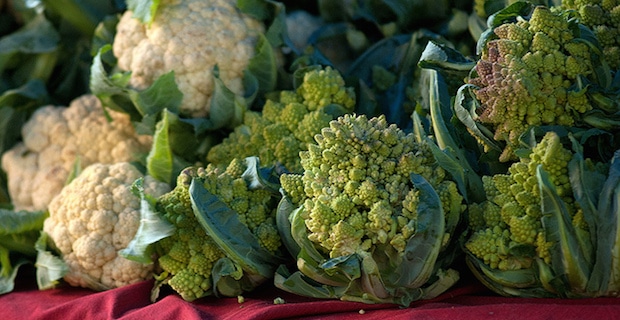
The benefits of cauliflower can't be overstated.
When most of us were kids, the sight of cauliflower on our plates usually inspired grimaces, followed by covert attempts to pass it to the dog when mom wasn’t looking. I, however, wasn't one of those kids, because I actually liked cauliflower. Still do. Back then, I enjoyed it because I liked the flavor. It wasn't until years later I learned about cauliflower health benefits and the myriad of cauliflower recipes I could make and enjoy. Among them are some vegan cauliflower recipes such as orange marinated grilled cauliflower steaks and a simple mashed cauliflower recipe.
Not only are cauliflower-centric dishes delicious, but they’re nutritionally winners as well. To follow are 5 reasons why I encourage you to put more cauliflower in your life–preferably two to three servings a week–and enjoy every bite.
1. Cauliflower Takes Direction Well
Versatility, thy name is cauliflower! Roast it, grill it, mash it, rice it, puree it, stir-fry it. Smother it in healthy, healing spices like curry, fennel, black pepper and turmeric, snack on it raw or serve it up old school, simply steamed. No matter how you prepare it, cauliflower is a mealtime culinary champ. You can even use cauliflower in dessert recipes!
2. Cauliflower is Inexpensive and Available Virtually Everywhere
Whether you’re on a budget or not, cauliflower fills out your plate with lots of wonderful nutrients and fiber at a very reasonable price. The average 3 lb. head of fresh cauliflower will set you back roughly $3 – $4, making it a pretty good deal per pound. (Organic will be a bit more.) You can also eat the leaves and stalks so there’s minimal waste to boot. Another plus: the Environmental Working Group has cauliflower on its “Clean 15” list, so it’s not imperative that you buy organic–the offerings from the local farmers’ market or supermarket will work just fine. No time to chop? Take a shortcut: many recipes work equally well using super-convenient frozen, bagged cauliflower.
Read more about how to buy healthy food on a budget
3. Cauliflower Brings Loads of Nutrition to the Table
There are so many good things packed into a head of the often over-looked cauliflower, you might even call it a secret superfood. Just look what’s going on with this amazing cruciferous veggie. Cauliflower has:
- Antioxidants and anti-inflammatory nutrients to help keep your heart and brain healthy, as well as provide benefits for skin health
- High levels of vitamin C and K, and beta-carotene to help keep immunity strong
- Significant amounts of folate and fiber to support digestive health
- Benefits for weight loss because it is super low in calories, high in fiber, and makes you feel full
- Research indicating it can help in the fight against cancer
4. Cauliflower Comes in Colors Engineered by Mother Nature
The benefits of cauliflower are not limited to white florets alone. This nutritious vegetable also comes in green, orange, and purple. While some might consider them a bit garish, these more colorful cousins bring with them a few nutritional advantages worth noting. For example, purple cauliflower, which gets its rich hue from anthocyanin, is believed to have heart-protective effects, while the orange head offers upwards of 25 times more beta-carotene than the conventional white kind. It’s also worth mentioning that the vibrant-colored cauliflower options aren’t the result of modern genetic engineering or GMOs–they are possible because of naturally occurring mutations and selective cultivation, so enjoy!
Be Well Bonus: How to Buy Cauliflower
When it’s time to hit the produce aisle or the local farmers’ market, here are four simple tips to keep in mind:
- Look for bright white or colored, very firm heads. You don’t want any give.
- The leaves that surround the cauliflower head should be green and firm, not yellowing or wilting.
- Avoid heads with a slight tan or brown tinge–that’s nature’s way of saying they’re past their nutritional prime.
- For some fruits and vegetables, bigger doesn’t always mean better, but it can often mean less taste. Fortunately, with cauliflower size doesn’t matter at all, so an enormous one or a small one will taste equally good. (If you wind up with more than you can use, freeze the extra for future use.)
[Recipe] Almond-Crusted Cauliflower
Looking For Ideas on What to do with Your Cauliflower?
Try this Cauliflower Rice Recipe. It easy to make and makes a wonderful side dish for stir fries, curries, roasted veggies, your favorite protein and more. Here’s how to make it:
You Will Need:
- 1 medium head cauliflower
- 1 small onion
- 2 tablespoons coconut oil
- sea salt and freshly ground pepper to taste
Directions:
- Rinse and dry cauliflower, then cut into big pieces
- Place a few pieces into a food processor and pulse till it is crumbly and resembles rice, you could also do this by using a cheese grater and grating the pieces of cauliflower.
- Peel and dice onion.
- Heat coconut oil in a large pan, add onion and saute till lightly browned.
- Add “riced” cauliflower and saute till cooked but not mushy (about 8 minutes)
- Season to taste with salt and pepper
The bottom line
Now that you know the many benefits of cauliflower, what are you waiting for? Head on out to your favorite produce market, pick up a head, and start cooking!
Image: U.S. Department of Agriculture










